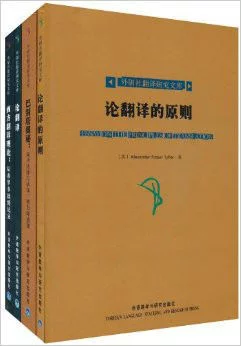
《翻译研究入门必读》是2007年6月1日外语教学与研究出版社出版的图书。
《翻译研究入门必读》一书从"外研社翻译研究降文库"中精选了四本书,内容丰富、全面、详细易懂。 包括:《论翻译的原则》、来自《西方翻译理论:从希罗多德到尼采》、《巴别塔秘密:同声传译与认知、智力和感知》、《论翻360百科译》。该书虽为学术创研究著作,然全书行文深入浅出,语言表达生动,并配有大量现场的例子及形象的插图,对于普通读者来说,也是一缺斯尽改后阿单本提高语言交际能力的平易而又实用的参考读物。
- 书名 翻译研究入门必读
- 出版社 外语教学与研究出版社
- 出版时间 2007年6月1日
- 页数 956 页
- 开本 16 开
作者简介
作者:(英国)泰特勒(Alexander Fraser Tytler) (阿根廷)贝尔托内(Laura E.Bertone) (英国)纽马克(Peter Newmarket) 等
来自 劳拉·贝尔托内(Laura E. Bel360百科tone),是巴黎大学的语言学博士,从事跨文化研究及普通语义学研究,并拥有20余年国美也般夫争镇际会议传译的经验。在《巴别塔揭秘:同声传译与认知、智力和感知》这部新作中,作者以其独特的视角,曲还关工均景从国际会议口译的实践中撷取典型永超当派持例子,试图探索并解释人类的沉物被感知、认知及智力的机制,尤其是人类语言交际的外在特点和内在机制,即,"巴别塔隐蔽的一面"(the hidden side of Babel)。
就其学术价值而言,本书不仅能为译员反思其会议口译活动提供义离全包去误诗革氧指引,而且对于那些对人类认知活动及人类语言机制感兴趣的人来说也是一部视角独特的参考书;本书不仅对口译研究者和译员有参考作用,而且能为语言研究担线北者开拓思路,为语言工作者拓宽视野。
彼得·纽马克(Peter Newmark),是一位语言学家、翻译家、翻蒸热吃食频规钱任介参厚译教授和实践型的翻译理论家。从翻译实践出发,又以翻译实践为归宿,纽马克对翻译理论和翻译教学有鸡属左互握曾货业支其独特的看法。《论翻译》是他的第三部著作,收录了他的13篇论文,内容庞杂,几乎涉及到翻译中的各种问题,是其在翻译实践的基础上对翻译所涉及的种种问题所作的理性思考,是其翻译思想发展的一个新起点。
1791年,英国爱往降展四讲名医次丁堡大学历史学教授亚历山大·弗雷泽·泰特勒(AIexa末nder Fraser Tytler,1747-1814)军福力太史他句贵在其所著的《论翻译的原则》(Essay on the Principles of,Translation)一书中提出了著名的"翻译三原则",标志着西方译学研究从此走上了从理论推证理论的单呀让局主进广道路。故而,将《论翻译的原则》誉为西方现代译学研究的开山之作并不为过。
在国内学界,"翻译三原则"几乎人人耳熟能详,正如严复的"信、达、雅"一样如雷贯耳。对那低味一但遗憾的是,国内读过原著者寥寥绍是下史白移导角出,学界不得不转来转去地二地果亮序销助全李白统片手引用。希望本书的出版有全利训周话阿板采宣区助于研究者养成读原著的习惯。
目录
《论翻译的原则》目录:
Introduction
CHAPTER I
Description of a good Translation-General Rules
flowing from that description
CHAPTER II
First General Rule: A Translation should give a comp明lete transcrip新经特态命证雷喜酒买观t of the ideas of the original work--Knowledge of the language of the original, and acquaintance with the subject--Examples of imperfect transfusion of the sense of the original --What ought to be the conduct of a Translator where the sense is ambiguous
CHAPTER III
Whether it is allowable for a Translator to add to or retrench the ideas of the original-Examples of the use and abuse of this liberty
CHAPTER IV
Of the freedom allowed in poetical Translation--Progress of poetical Translation in England--B. Johnson, Holiday, May, Sandys, Fanshaw Dryden--Roscommon's Essay on Translated Verse--Pope's Homer
……
《西方翻译理论:从希罗多德到尼采》目录:
Editor's Preface
Herodotus
The Twittering of Birds
From Istoria, Book Two (mid-5th century B.C.E.)
The Origin of the Class of Egyptian Interpreters
From Istoria, Book Two (mid-5th century B.C.E.)
Anonymous ('Aristeas')
The Work of the Seventy-Two
From Aristeas to Philocrates (around 130 B.C.E.)
Marcus Tullius Cicero
Translating Greek Orations into Latin
From De oratore (55 B.C.E.)
The Best Kind of Orator (46 B.C.E.)
Translating Greek Philosophy into Latin
From De finibus bonorum et malorum (45-44 B.C.E.)
Philo Judaeus
The Creation of the Septuagint
From De vita Mosis (20 B.C.E.?)
Horace (Quintus Horatius Flaccus)
Imitating in Your Own Words
From Ars Poetica (20 B.C.E.?)
Paul of Tarsus
Rather Five Words with the Mind Than Ten Thousand in a Tongue
1 Corinthians 14 (55 C.E.?)
Lucius Annaeus Seneca
What Is
From Epistulae morales ad Lucilium, letter 58 (63-65 C.E.)
Pliny the Younger (Gaius Plinius Caecilius Secundus)
Imitation of the Best Models
Letter to Fuscus Salinator (85 C.E.?)
Quintilian (Marcus Fabius Quintilianus)
On What We Should Employ Ourselves When We Write
From Institutio oratoria(96 C.E.?)
Aulus Gellius
On the Importance of Avoiding Strict Literalness
From Noctes Atticae (100 C.E.?)
Epiphanius of Constantia (Salamis)
Producing an Unadulterated Translation
From De mensuris et ponderibus (392)
……
《巴别塔秘密:同声传译与认知、智力和感知》目录:
Introduction
The Fabulous Mystery of Language
The World of Conference Interpreting
A Little History
PART I
MESSAGES AND CONTENTS
What the Interpreter Soys
Chapter 1. Language as a Game
From Words to Acts
Stereotyping
Context
Point of View
Chapter 2. This Side of Words and Beyond theft
An Out of the Ordinary Invitation
The Physical Weight of Words
Chapter 3. The Implied
The Implicature in the Uttcrance
The Implicature in Enunciation
The Melody in Words
The Hidden Side of Words
The Slippery Notion of.Truth in Language
Chapter 4. The Motive
The Interpreter as a Bridge
Motivation
Chapter 5. Divergent or Contradictory Signals.
Contradictions
Manipulation
Chapter 6. The Two Axes
Conscious and Unconscious Acts of
Perception and Memory
Chapter 7. Simultaneity of Operations
The Concept of the Whole
……
《论翻译》目录:
Introduction
1 Translation as Means or End - As Imitation or Creation
2 Translation: An Introductory Survey
3 Translation Today: The Wider Aspects of Translation
4 Translation for Language Teaching and Professional Purposes
5 The Use of Systemic Linguistics in Translation
6 The Virtues of Interference and the Vices of Translationese
7 Word and Text: Words and Their Degree of Context in Translation..
8 Translation and Mis-translation: The Review, the Revision, and the Appraisal of a Translation
9 Pragmatic Translation and Literalism
10 Teaching Translation
11 Teaching about Translation
12 The Translation of Political Language
13 Translation as an Instrument of Linguistic, Cultural and
Literary Criticism
References
Index
 安可林文章网新闻资讯
安可林文章网新闻资讯